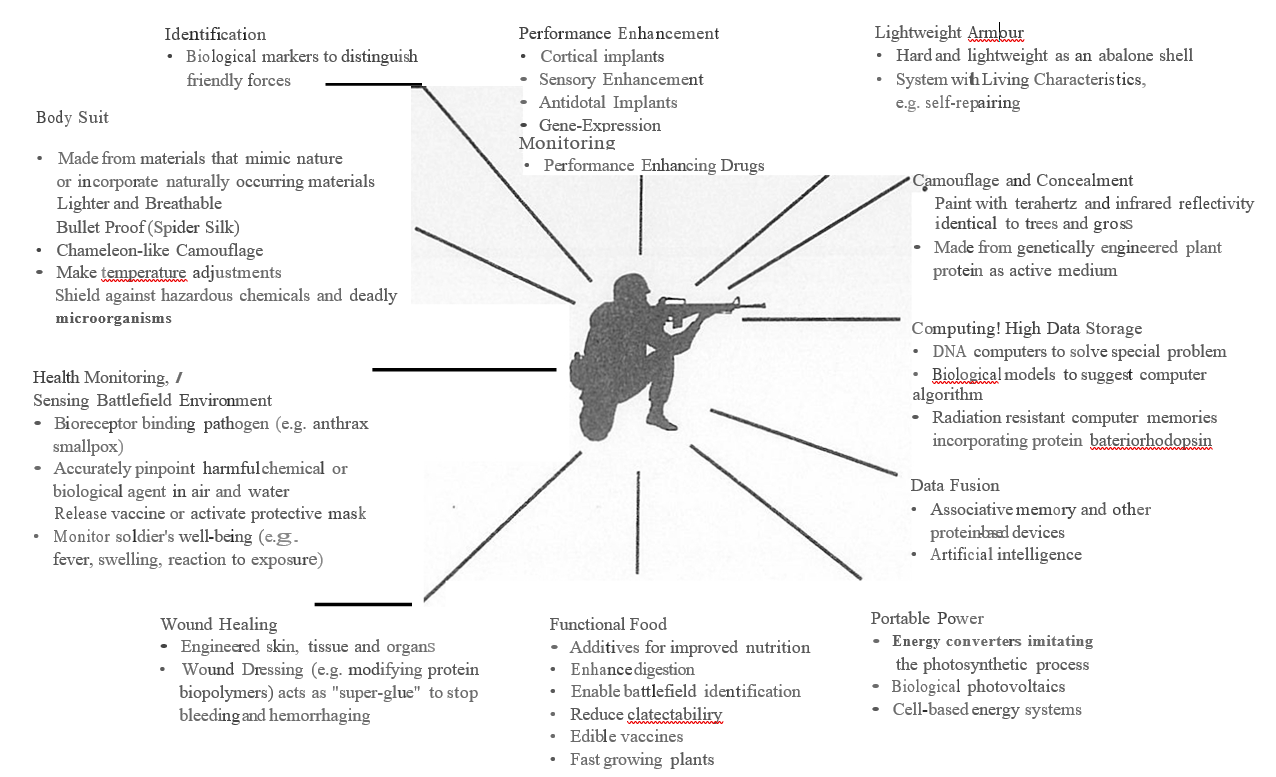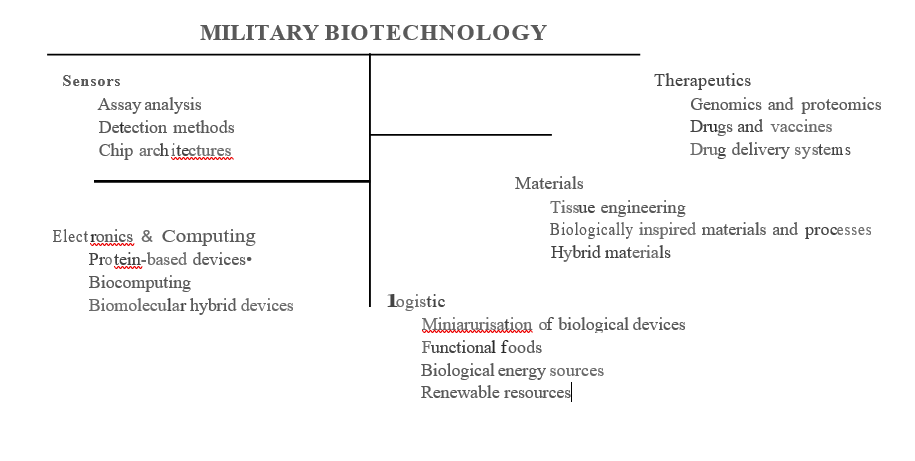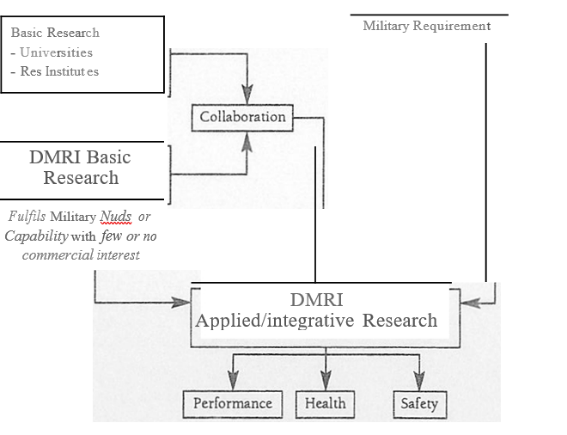ABSTRACT
PROGRESS IN THE LIFE SCIENCES will be driving scientific progress in the 21st Century the way physics did for the 20th Century. The new revolution in Biotechnology indicates that the warrior of the future will be drawn from a society very much influenced by this development. Bio-sensors may detect potential threats of all kinds. Biologically inspired materials could provide light protective armour. Trauma therapeutics will enhance survival from wounds. The future prospects of defence health research involve studying the changing situation of the modem battlefield, the new threats to which the combatants are being subjected and the overwhelming potential of discoveries in the life sciences and biotechnology. By this, defence health research will achieve three main purposes, enhance the safety and health of service personnel, maximise their survival on the battlefield and improve their combat performance.
INTRODUCTION
At the dawn of the new millennium, it has been said concerning progress in the life sciences that the 21st century will become the age of new Biology. Biology will be driving scientific progress for this century, the way Physics did for the 20th Century. It was thus not just pure coincidence that the first draft for the human genome project was completed in Feb. 2001. This landmark breakthrough will yield so much promise for new discoveries in life science.
The warrior in 2020 will be drawn from a society that has been armed by biotechnology. They will have increased strength, endurance and superior resistance to disease and ageing. By then Biosensors may be able to detect threats of all kinds. Biologically inspired materials could provide light protective armour. Trauma therapeutics will enhance survival from wounds. Against such a backdrop of future promise, there is so much opportunity for those of us engaged in defence health and medicine to harness these new discoveries for the benefit of defence health.
DEFINING RESEARCH PROGRAMMES
The central focus of R & D activities of the Defence Medical Research Institutes (DMRis) is the warfighter operating as individuals or in teams. There are three main purposes:
- To enhance the safety and health of the service personnel.
- To maximise their survival on the battlefield.
- To improve combat performance.
In order to make a greater and significant contribution, researchers need to understand three trends:
- The changing situation of the modern battlefield
- The threats to which the combatants are being subjected
- The overwhelming potential in the recent discoveries in the life sciences and biotechnology.
There should be a push-pull relationship in defining needs for research. The main sponsors of the research, which are the operational staff of the army, navy and airforces and particularly from the Medical Corps, articulate the requirements. At the same time, creative ideas should also be articulated by the research scientists and engineers (RSEs) in whom domain knowledge reside. From such a relationship, innovative solutions to problems will result.
APPRECIATING THE BATTLEFIELD
The modern battlefield presents an ever-changing land scape and challenge. It will be fought with increasing tempo and precision. Large battle formations will be replaced or complemented by small group forces spread over a wider dispersion. Modern weapons are much more lethal and devastating. The threat of chemical and bioweapons with their asymmetric impact is real. Precision weapons and improved mobility bring along
a technical complexity to the battlefield.
All this points to an overwhelming individual burden challenging physical and cognitive endurance. Operations other than war, terrorism and long intensity conflicts will force the defence health services to move out of their traditional scope of looking after operational forces to attending to civilians victimised by these conflicts.
TABLE 1: Threats in a Battlefield Environment
| Category | Threats |
|---|---|
| Environment | Heat, Cold, G-Forces, Altitudes, Hypoxia, Undersea, Submarine |
| Materials | Toxic Chemicals, Radiation, Infections and Biological agents, Laser, Explosives, |
| High-Velocity Missiles, Non-lethal weapons, Infrasound | |
| Metabolic | Physical Exhaustion, Fatigue, Dehydration, Sleep Deprivation |
| Mental/Cognition | Fear, Chronic Anxiety, Information Overload, Battle Stress |
HARNESSING THE LIFE SCIENCES INITIATIVES
Recent advances in the field of genetics, genomics and proteomics will alter the approach, diagnosis, treatment and prevention of diseases. With genetic profiling, the effect of individual genetic elements on dis ease and fitness can be determined. Genomics-based therapeutics approaches will become the norm.
Assuming that the issues relating to personal privacy can be overcome, the military has a unique opportunity to collect and use genetic data. It would be of great value to the military to increase the epidemiological monitoring of troops and to add genetic information to such studies. Because genetic information offers clues to improving human performance, it could provide the army with means of increasing combat effectiveness. Then applying artificial intelligence techniques, such as neural networks and machine learning processes, we should be able to data-mine the wealth of genetic and epidemiological data. The challenge is in the ability to organise these efforts and intelligently tap this potential wealth of information purposes of manpower selection and preventive medicine.
EXPLOITING BIOTECHNOLOGY
The rapid growth of the biotechnology industry is evident from the statistics in Table 21. In 1985 approximately 1,500 biotechnology patents were granted in the United States. By 1998, the number had increased more than 9000. Between 1994 and 1999, market capitalisation more than doubled from US$45 billion to almost US$97 billion, which is more than the estimated US$75 billion for the entire US defence industry1 at that time.
TABLE 2: Biotechnology Industry Statistics in the USA 1993-1999 (in US$ billions)
| Year | 1993 | 1994 | 1995 | 1996 | 1997 | 1998 | 1999 |
|---|---|---|---|---|---|---|---|
| Sales | 5.9 | 7.0 | 7.7 | 9.3 | 10.8 | 13.0 | 13.4 |
| Revenues | 8.1 | 10.0 | 11.2 | 12.7 | 14.6 | 17.4 | 18.6 |
| R&D | 4.9 | 5.7 | 7.0 | 7.7 | 7.9 | 9.0 | 9.9 |
| Market Capitalisation | N/A | 45 | 41 | 53 | 83 | 93 | 97 |
| Number of Companies | 1,231 | 1,272 | 1,311 | 1,308 | 1,287 | 1,274 | 1,283 |
| Number pub listed cays | 225 | 235 | 265 | 260 | 294 | 317 | 327 |
| Number of employees | 79,000 | 97,000 | 103,000 | 108,000 | 118,000 | 141,000 | 153,000 |
FIGURE 1: THE BIOTECH SOLDIER – The possible applications of biotechnology for military use

FIGURE 2: Military Biotechnology

BIO-SENSORS
The operational environment carries unseen and not so obvious threats to the combatant. Unsafe air, water and food should be detected early for prevention and intervention to counter these threats to become effective. The advances in microelectronic mechanical systems (MEMS), microfluidics and nanotechnology open up the exploitation of using bio-sensing as early warning devices of environmental threats or from biological and chemical
attacks. Small bio-sensors will probe the environment for specific threats through chemical, biochemical or biological assays. DNA chips provide the potential for miniature devices to diagnose a variety of disease threats with speed and specificity. These will be simple, small and robust for field use.
BIO-MATERIALS
There is a need to protect the war-fighter and should the protection be breached and wounding occurs, there is a need to repair the wounds. Bio-materials and bio-inspired materials have the potential to change the mindsets as to how these two requirements of protection and repair can be achieved. Bio-materials are biologically produced materials. Tissue engineering and stem cell research will offer inherent advantages over synthetic materials for wound healing. They are self-replicating. On the other hand, synthetic materials soft or hard, bio-inspired materials could be used in vivo or in vitro. An example would be the inspiration of the spider web to make strong and resilient scaffolds or the abalone shells for body armour.
BIO-COMPUTING
Bio-computing integrates computer science and biology. It builds computational models of biological systems or to use biological processes as enablers to develop new computational techniques. For example, artificial neural nets are computer algorithms that mimic the way neurons process information.
THERAPEUTICS
New technologies will lead to the development of new drugs and vaccines, which through the pharmacogenetics will be tailored to suit individual soldiers. There will be a cheaper means of discovering and testing new drugs. With micro and nano-technology, advanced drug delivery systems can be developed to introduce drugs via micro-needles or implanted devices. Drugs and vaccines can also be introduced through genetically processed foods.
CONCLUSION
Advances in the Life Sciences and Biotechnology are often made possible through a broad front, multidisciplinary approach. For example, research in bio-mate rials involves the disciplines of biology, nanoscience, medicine and biomimetics. This is where the DMRls provide value add service to the armed forces they serve.
DMRls are poised in our niche for integrative/applied research to bring together the new science and technology from basic research and point them towards fulfiling military needs and requirements. In this way, we will be exploiting the advances in life sciences and biotechnology and so improve the performance, safety and health of the men and women in our armed forces.
FIGURE 3: Role of Defence Medical Research Institutes







